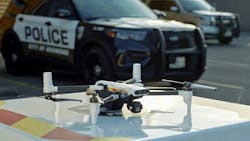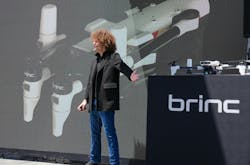Ready to Respond: BRINC Offers One-Stop Drone Solution for Police
Drone as First Responder (DFR) programs have taken to the skies over the past couple of years all over the country. Advances in technology, more affordable devices and services, and a proliferation of U.S.-manufactured drones has allowed more law enforcement agencies to launch their own programs. Many of those agencies have been in search of a one-stop solution for quite some time. With the launch of its Responder drone this spring, BRINC is providing an all-encompassing tool that can be controlled remotely.
This article appeared in the July/August issue of OFFICER Magazine. Click Here to subscribe to OFFICER Magazine.
Blake Resnick, founder and CEO of BRINC, and Don Redmond, BRINC’s Vice President of Advanced Public Safety for Projects, shared their vision for the company and why they think the Responder can be the UAS product agencies have been looking for.
Responding to a need
BRINC launched about four years, ago, but Resnick first began developing the idea for the company following the Oct. 1, 2017, Route 91 Harvest Music Festival shooting on the Las Vegas Strip in which a gunman fired more than 1,000 rounds from the window of a room in the Mandalay Bay hotel, killing 60 people and wounding more than 400. “After October 1, I set up a meeting with the Vegas Metro Police Department and we talked about what happened during the Manadlay Bay shooting and we talked about the rest of their jobs,” he says. “But there were two big things that really stuck out to me from that conversation. The first was that the shooter put a baby monitor camera outside of his door in the Mandalay Bay and it was pointing down this 100-yard-long hallway to the elevator. He had a separate weapons cash right inside of his suite. His plan was he would have seen first responders coming and could have just fired down the hallway and that obviously would have been a really bad tactical situation.”
According to Resnick, that conversation and others about high-risk warrant searches, barricades and hostage rescue missions inspired him to create a drone that could get eyes and ears in dangerous places, look around indoors and give first responders more information so they can make better decisions. That idea became the BRINC LEMUR Tactical line of drones.
“The second problem we talked about was that it took first responders over an hour to make entry into the room where the gunman was firing from in in the Mandalay Bay.,” he says. “One of the reasons why that happened was, as plainclothes police and security all over the strip took out their weapons, they were misidentified as additional active shooters. That got even worse, later in the shooting, when people that were injured or near people that were injured and might have had blood on their clothes, they distributed throughout the strip too.”
The reports to 911 of multiple active shooters led first responders to believe it was a coordinated terror attack at multiple different sites, and they sent resources to all of those locations. “From the very beginning, I envisioned a drone that could respond to those 911 calls and then confirm what dispatch was hearing.” Since the release of the LEMUR line, BRINC has grown 110 employees and 10% of the SWAT teams in the country are using their technology, which made it the right time to launch the Responder drone.
Laying the foundation
Don Redmond retired as a captain with the Chula Vista Police Department in 2022 after spending more than 25 years in law enforcement. He managed the CVPD’s UAS Program, including the D FR program. “While I was at the Chula Vista Police Department, I met Blake and the team from BRINC who were interested in developing a DFR solution. They came to tour our program, and over the next few weeks, Blake and I communicated and I learned more about what he was trying to accomplish,” he says. “He was really passionate about protecting public safety and the community and wanted to build the best drone possible. I was really impressed. When I decided to retire, I reached out to Blake to see if I could join his team.”
The Chula Vista Police Department’s UAS/DFR program is world-renowned and Remond believes his experience in building the world’s first DFR program and expanding the UAS team has given him valuable insight into the challenges and obstacles agencies face in developing their programs. According to Resnick, Redmond’s input was integral in the development of the Responder drone. “Don has influenced the product a lot,” he says. “Chula Vista really invented the concept of the bonus first responder truly. It’s an incredibly tenured program. They’ve responded to almost 20,000 911 calls at this point. So, he’s been an amazing source of feedback.”
Despite Chula Vista’s role in creating DFR, Resnick noted that the program still very manual in how drones are deployed and relies on staffing the program. “They have people on rooftops swapping out batteries because they don’t have automated nests. And then, those people are also functioning as visual observers,” he says. “They’re having to look around and try to see manned aircraft. If they do, they ground the drones or redirect them. This has been a major problem and barrier to the widespread adoption of DFR.”
Building the right solution
The Responder drone includes a docking system, groundbased radar and a software solution, which Remond says makes the Responder a game changer in the industry. “The biggest challenge any DFR program is the FAA requirement for a Visual Observer (VO). With our new solution, DFR is now embedded in public safety operations for ease of use.”
According to Redmond, community support and funding were two challenges that Chula Vista faced when trying to establish a DFR program. “The CVPD ensured we had strong community support before we ever launched a drone,” he says. “We did community outreach, city council presentations with public comments, and media releases to ensure there were no surprises from the community when we started DFR. We integrated a public transparency portal which is now the benchmark for other DFR programs. Funding was always difficult. We had to move away from seeing drones as just pieces of equipment, to the concept that drones are a small piece of an overall UAS program that includes equipment, software, training, manpower, regulations, policy, and public outreach.”
As part of the Responder suite, BRINC has developed a public transparency portal that agencies can customize. The drones also include public safety markings, red and blue lights, and a siren for ease of identification by the community. “As with any agency, identifying funding and determining a budget for any program is always difficult,” he says. “BRINC has introduced the first all-inclusive BRINC SafeGuard Program for UAS programs. Everything is included including a no-questions-asked warranty, free upgrades, training, assistance with FAA regulations, software, etc.”
BRINC also works with agencies to understand their specific needs and develop a five-year strategy. “This has been extremely positive and helpful for agencies to make their UAS program a line-item in their budget,” he says. “There are no worries about trying to find additional funding if a new drone is released or a drone pilot damages the drone in training.”
The biggest infrastructure issues are FAA regulations. The challenges of requiring visual observers for every drone launch is difficult especially for the staffing crisis facing all public safety agencies. Redmond says the FAA has been delayed on their long-term plan on how to safely integrate drones into the public airspace with manned aircraft. Because of this, DFR is still being operated today as it was when we first launched DFR in October 2018.
“The FAA has made great strides in quickly approving waivers for public safety to utilize drones,” he says. “BRINC has partnered with a ground-based radar company to provide safety use cases in the ability to operate DFR safely without the need of a visual observer. Once the FAA approves a wide-scale adoption, the ease of implementing DFR will be greatly increased.”
Redmond believes that eventually, BRINC’s all-in-one solution will see a large-scale adoption. “The ability to customize your entire drone program needs at a fixed cost, with no surprises or nickel and diming, provides the confidence to public safety agencies and the community of the sustainability of the program,” he says. “Additionally, agencies do not have the time or manpower to search different drone platforms, which software will work with what, learn about FAA regulations, etc. Drone technology is always improving. With BRINC’s all-in-one solution (SafeGuard) agencies know they will always have the best-in-class UAS solution, allowing their personnel the ability to focus on serving the community.”
Looking toward the future
Resnick says that in some form or another, well over three years has been spent developing the Responder drone suite.
“The drone industry is really quite monopolistic. There’s really only one company in the drone industry, and that is DJI. They have over 90% of the market share in the U.S.,” he mentioned, adding that while other U.S.-based companies manufacture drones, a large percentage of their business is focused on military and commercial interests. “I think a big differentiator for BRINC is that we only sell to public safety. We really are a first responder drone company. We only sell the public safety customers. It gets into the founding of the company and our history. There are also a really large number of police and fire departments in the country, and when you try to start servicing multiple industries, you have to make really painful trade-offs. For example, the military wants their drones to have certain radios on board that might operate at frequencies that aren’t generally allowed in the U.S., or they might be super expensive parts that aren’t actually much higher performance than what you can get on like the commercial side.”
“According to Resnick, if a company is designing a drone for law enforcement and also for DoD, DoD is pulling you hard in one direction. That might force you to make bad compromises. We don’t want to put ourselves in that position. We want to build the best public safety drones ever,” he says .”We talk to customers about what to build and what the right software integrations are and the features that matter and what the right trade-offs are between capabilities. For example, there’s a trade-off between max speed and flight time that you have to get. You optimize for one at the expense of the other. We have those conversations and we’re really lucky. We have over 500 contracts with public agencies all over the country, so there are a lot of folks that we can call up and get feedback.”
Resnick says that a lot of agencies are drawn to adopting DFR for its ability to clear out low-priority calls. “A lot of the technology we’ve built is very much designed to help alleviate those problems,” says Resnick. “The nests are designed to eliminate the need for a person swapping batteries, and then we can also install ground-based radar, ADS-B receivers and mesh networking radios around cities to get full network coverage, so the drone can always fly around and you know that it’s going to have a good connection back and also to detect both compliant and non-compliant aircraft.”
He says that if an aircraft is broadcasting their location with a ADS-B, BRINC’s solution can receive that. But, even if they’re not broadcasting for some reason, it can pick them up on radar, allowing agencies to get around the visual observer. “With all of that technology, you just don’t need a lot of staffing for DFR, you just need one teleoperator, and that person can control even multiple launch sites,” he says. “BVLOS (Beyond Visual Line of Sight) waivers are much less of a challenge for agencies to get now than they ever have been. The part that is complex is a BVLOS without a VO (Visual Observer). If you want to do these two-mile range DFR flights, but without a person on the rooftop, that is complicated. It is precedented.”
According to Resnick, an agency in Pearland, Texas, has received one of those. They’re using the Iris Casia G System, which is a camera-based system to detect compliant aircraft. “We’re in the process of applying right now with an agency for a BVLOS waiver without a VO that is utilizing our radar solution. I think the second that’s precedented and approved, it will really allow for more widespread installation and proliferation of DFR programs, but it’s still in the early days,“ he says. “I really hope that the FAA approves our waiver as written. If they don’t, we’ll continue modifying it and try over and over again. But, I will say that our radar system has better performance characteristics than the system that was already approved by the FAA to detect non-compliant aircraft. We’re optimistic about it.”
Resnick says that through BRINC’s Safeguard subscription offering, agencies receive an initial delivery of hardware. When BRINC releases the next generation of its drones, agencies will automatically get upgraded. If the drone ever crashes, BRINC will replace it and include software for the agency with DFR.
According to Resnick, there are wear items like batteries, which are only good for 400-500 charge cycles and motors on the on the drones are only good up to a certain number of flight hours. Even the nest can only cycle open and close a certain number of times before they need servicing. As the hardware becomes due for service, BRINC will send technicians out, replace batteries, replace motors and service nests.
BRINC has signed four citywide 911 response drone network contracts before the product is even launched. Those will be delivered in quarter four of this year. “We’re talking to another 150 agencies right now about adopting the technology,” Resnick says. BRINC also recently partnered with Skyfire to help with the application process for BVLOS waivers and the COA (Certificates of Waiver or Authorization) process, which is a service included with the Safeguard program.
Taking the next steps
Resnick says that a a majority of the agencies BRINC has spoken to started off with the DJI drones and have used them as eyes in the sky for overwatch purposes and in some cases they’ve also started up vehicle- based DFR programs where they might be deploying drones out of the trunks of patrol cars. He says when Chula Vista created its DFR program, the agency purchased aircraft from one company, teleoperations software from another and telemetry management software from another. While also working with yet another company to get regulatory support and to provide staffing.
“It’s just like this crazy piecemeal thing where you need like six or seven different vendors in order to start the thing up. What BRINC offered is a full end-to-end solution. That’s all the hardware, software, services, the regulatory stuff, everything. All an agency has to do right now in order to decide they want to adopt DFR is reach out to us. They just have to press one button, have one vendor relationship.” Resnick stresses that with the Responder drone and the Safeguard program, agencies no longer need to wait on adopting DFR. “I think that with this end-to-end solution, we’ve made it so easy for agencies to adopt DFR. If they’re interested in the concept, they should reach out.”
About the Author
Paul Peluso
Editor
Paul Peluso is the Managing Editor of OFFICER Magazine and has been with the Officer Media Group since 2006. He began as an Associate Editor, writing and editing content for Officer.com. Previously, Paul worked as a reporter for several newspapers in the suburbs of Baltimore, MD.



